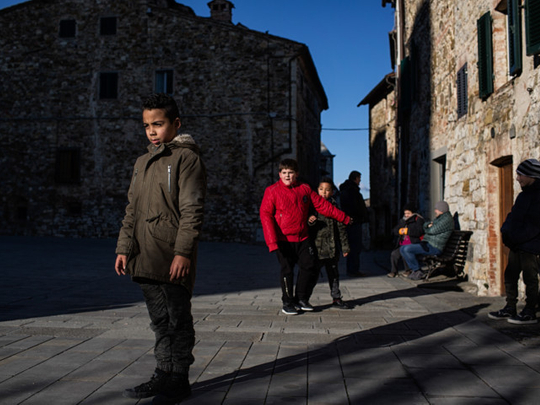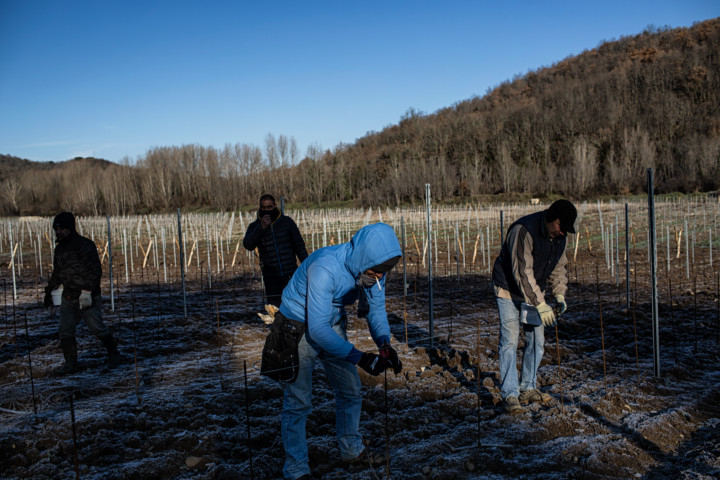
The three-storey school building hasn’t changed much. The blackboards still hang against the ochre-coloured classroom wall. Even the morning ritual is familiar: Two students walk through the rows of tiny desks to collect the exercise books, which are still stacked inside in the same storage closet used during the late 1980s, when I was a primary school student in Castellina in Chianti.
What has changed are the students. When I was growing up, only one of my classmates was from somewhere else, a boy who arrived from Grosseto, roughly 60 miles away, to our ancient walled town of 2,800 people. Like me, he was from Tuscany, but he seemed like an exotic stranger.
Today, more than half the 23 second-graders have parents from Afghanistan, Albania, Bosnia, Macedonia, Morocco, Pakistan or Tunisia. Five were born in their family’s country of origin or in transit to Europe. This is the new Italy.
Initially, I didn’t pay close attention to what was happening in my village. I was part of a different migration: the flood of Italians in their 20s, 30s and 40s who had earned college degrees and then left villages or small towns, where job options are limited. Some had moved to Berlin, Denver, London or Paris, where one of my closest childhood friends now lives. I landed in Rome, among those who moved to Italy’s big cities in search of work.
For many visitors, a great allure of Italy is the sense that nothing changes, whether the timeless beauty of Rome or Florence, or of villages like Castellina, where the castle and the original fortification were built in the 1400s. But change is now rippling through the country. No issue is more inflammatory than migration. No issue is more deeply felt than the weak economy that has plagued my generation.
What I hadn’t expected was the way both issues had quietly reshaped my village. My family has lived in Castellina for generations, and I’m the granddaughter of a farmer, in this region famous for its wine. Yet migrants now tend many of the fields or care for many of the elderly, while some of their children and grandchildren have moved away. Today, 17 per cent of the population in Castellina arrived as migrants.
Take what has happened in Castellina and multiply it by thousands to understand how Italian towns and villages are changing. No place has reacted like any other; sometimes, the reaction has been ugly. Last month, a far-right supporter shot six African migrants in the central city of Macerata. Some right-wing politicians have denounced an “invasion,” with one warning that migrants posed a threat to the “white race.”
Nationally, the immigration issue is so toxic politically that, before Christmas, parliament balked at passing a law to naturalise 800,000 children — some arrived at a young age with parents who have long-term residence and work permits, while others were born in Italy. That means that many of the second-graders in Castellina live in limbo.
I had seen migrants working in the fields for a few years, as well as a couple of veiled women walking around Castellina, but I didn’t fully understand how the village was changing until last year, when I spoke with Francesco. He is 9, and my mother has been his baby sitter for eight years, making her his honourary grandmother.
One night over dinner, Francesco told me how sad he was that his friend Igor, a Ukrainian refugee, had left. Igor had explained that he could return home because bombs were no longer falling and his father had been discharged from the army. I was startled by Igor’s story, but also that Francesco knew so much about global affairs through his friends at school.
On a recent morning, I went to the primary school and met the second-graders, who insisted on writing their names in my notebook because they said the names are hard for Italians to pronounce, just as it is hard for some immigrant children to master Italian.
“Our language is complex,” the teacher, Maria Luisa Roscino, told me. “Children are fast to learn, but at home they don’t speak Italian — and that puts them at a disadvantage.”
Roscino began teaching in Castellina in 1998. This is her first class in which most students — 51 per cent — were either born abroad or had foreign parents. “It is challenging, especially in terms of cultural differences,” she said. “For the rest, children are children.”
A few years earlier, I was on an Italian coast guard ship, working on an article about the drownings of migrants trying to cross the Mediterranean. We came upon a rotting wooden fishing boat, overweighted by desperate people, many of them Syrians who were fleeing war and had paid smugglers to make the dangerous passage. As the coast guard loaded everyone onto the rescue ship, a 4-year-old boy from Damascus stared at me and smiled. For two hours.
“He says you look like his mother,” his father told me through a translator, “who died under the bombs in Syria.”
The next morning, I visited the boy in one of the centres in Sicily where local governments were housing the migrants. He was chewing a cookie, his mouth full of crumbs as he blew me a kiss. He reminded me that the only difference between his mother and me was that I was born in Tuscany, not in Syria.
What brought more Syrians to Tuscany — as well as Bangladeshis, Gambians, Nigerians and so many others — was a 2015 national policy to relieve the burden on Sicily by accelerating and expanding the distribution of migrants throughout the country. By then, European leaders had blocked the route north, shutting down the migration trails through Italy or the Balkans, even as people kept coming across the Mediterranean.
Many Italians had opened their homes to migrants. Migrant soccer teams were formed. Italy was praised globally for its welcoming, big-hearted embrace. But as migrants kept coming, and were placed in every region of the country, resistance and anger began to bubble up.
Some jurisdictions tried to block migrants. Matteo Salvini, leader of the anti-immigrant, right-wing League Party, has held rallies across Italy, pushing an “Italians first” platform and accusing the centre-left government of turning the country into a “large refugee camp.”
Castellina now has residents from sub-Saharan Africa, as well as Kosovars, Moroccans, Tunisians, and others. A delegation from the League eventually arrived to protest the latest resettlement, but they failed to stir up much anger — Tuscany has been a leftist stronghold for decades.
I left Castellina in 2005, but am one of the many Italians who crowd trains and buses on Friday evenings to go to their home villages. I often spend my weekends with family and friends, many of whom also live elsewhere but return for visits. One weekend, I heard about a Pakistani woman, Lubna Batool, a doctor, who now lives here. When I visited the school, I met her and her daughter.
Batool had followed her Afghan husband, who was granted a residency permit in Castellina, and she joined him eight years ago, as Italy’s economic crisis had worsened. She worked as a surgeon in southwestern Pakistan, but she has been unable to find a job in Italy. She bought costly textbooks and travelled to Rome to take a complex exam to be credentialed as a doctor.
Today, Castellina has only two general practitioners, including my own, Dr Giuseppe Pacella. One of the thousands of physicians across Italy who are nearing retirement, he is encouraging Batool’s pursuit of an Italian medical certificate, partly because he worries about who will take his place.
“These people not only have degrees, but are also resilient,” Pacella told me. “They went through wars, moves and economic troubles. We need to integrate those who want to work, because we will all benefit from it.”
Yet coexistence and integration are different. In some ways, Castellina is much as it was when I was living there. The same baker’s shop is there, though the son has now taken over. The jeweller and electronics seller are the same team, a lady and her business partner; they can still fix almost anything, even if their hands are crooked and their eyeglasses thicker.
But many of the waiters and dishwashers in restaurants are migrants. So are many farmhands, including Batool’s husband, Ali Mohammad. I found him one recent morning in the vineyards amid frozen puddles and white frost, tying hooks to the wires that steady the grapevines — work my grandfather and other ancestors once did.
Afterward, some of the farmworkers went to the coffee bar that was my teenage hangout. In the afternoon, our retired postman joined the former tobacco shop vendor and other retirees to play cards in a backroom. In the evening, the migrants gathered on the staircase out front, the new face of the town’s social life. The old-timers and the newcomers rarely mix, inhabiting parallel worlds, divided partly by language.
Like many of my childhood friends, I have kept my formal residence in Castellina. We pay taxes here. We vote here. But we do not live here. Ours is the generation that left, out of necessity if not happily.
Yet my friends are still bound together by our village. When one of our grandparents dies, we all attend the funeral. When someone is married, we all return for the wedding. My heart is at peace when I look out over the vineyards and see the medieval stone tower in the distance.
Now, though, Castellina doesn’t belong only to me and my friends. I realised this when I met Bilal Al Hartika, 9, who was born in Tuscany to Moroccan parents.
I asked if he felt that he belonged here.
“I am Moroccan and Italian, from Castellina,” he answered, without hesitation.
“This is my home,” he said, adding in Arabic, “My dar.”
–New York Times News Service













